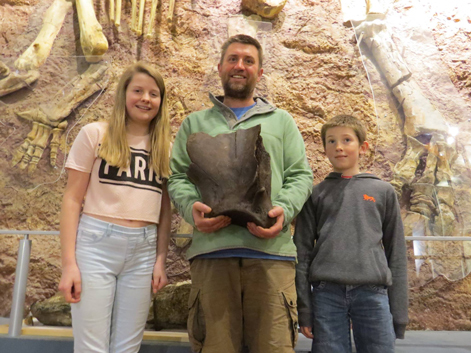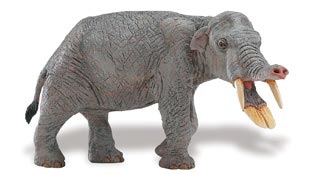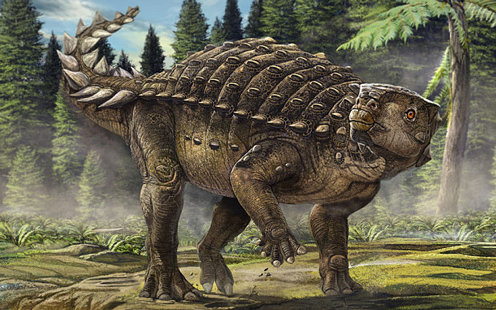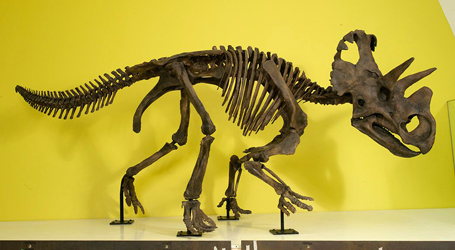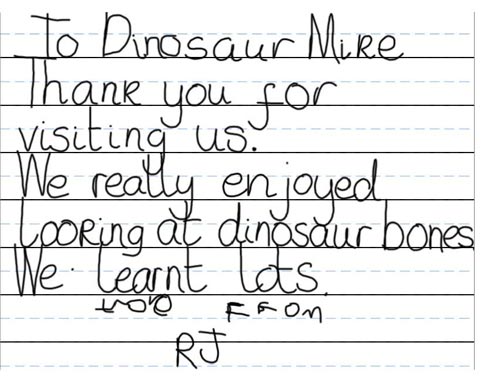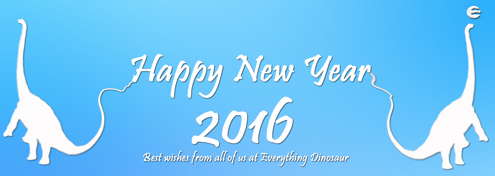Seek Out These Hidden Gems
According to VisitBritain, tourism to the UK swells our nation’s coffers by some £26.2 billion annually. In 2014, there were 34.38 tourist visits to Britain, feedback from tourists be they Americans, Australians, visitors from France, Germany or ever increasingly from China, cite our country’s wonderful history and heritage as one of the key reasons for their visit. However, for us Brits the fact that we have such a rich, varied and fantastic heritage sometimes gets overlooked.
We are very fortunate in this country to have some amazing regional museums, each telling the story of a small part of the British Isles, providing insight and access to some remarkable historical objects and artefacts. Take as an example, Dorking Museum and Heritage Centre, based as you might guess, close to the busy centre of the Surrey town of Dorking. For anyone with an interest in palaeontology, geology, or indeed for anyone eager to learn how these two sciences came into being, such places can provide a wonderful opportunity to indulge an inquiring mind.
Dorking 130 Million Years Ago
Dinosaurs once roamed this part of the world, in fact it is thanks to the fossil discoveries from such famous geological deposits that form the Wealden Group, that scientists in Georgian Times first had the opportunity to study the fossilised bones of the prehistoric reptiles that were to become known as the dinosaurs. The county of Surrey played an important role in the early days of palaeontology.
Add the fact that overlying these continental deposits of clays and sandstones is the equally important Lower Greensand Formation, a later sequence of deposits formed as sea levels rose, permitting this part of England (including Dorking) to became home to a vast array of exotic and for the most part, now extinct creatures.
Dorking in the Early Cretaceous

Dinosaurs once roamed Surrey (England).
Picture credit: Natural History Museum (London)
The picture above shows a large ornithopod (Iguanodon) in the foreground, with two hypsilophodont dinosaurs close by. An armoured Polacanthus slowly makes its way across the fern rich lowlands, whilst close to the shoreline a theropod dinosaur can be seen consuming its latest kill. The posture of the dinosaurs shown in this illustration is now a little outdated, but fossils collected from the various quarries that surround Dorking provide ample evidence that such creatures did indeed roam this part of the world some 130 million years ago.
On Display at Dorking Museum and Heritage Centre – Tail Bones from an Iguanodontid
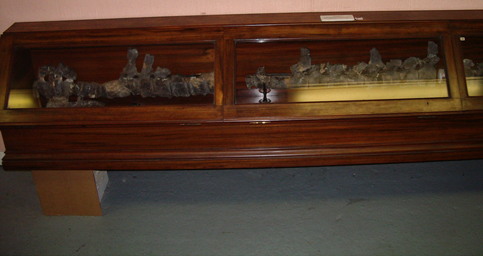
On display at the museum. Tail bones recently re-labelled as Mantellisaurus.
Picture credit: Dorking Museum and Heritage Centre
Everything Dinosaur stocks a range of ornithopod models and figures: Ornithopod models and figures (Dinosaur Models).
A Wealden Dinosaur
One of the local fossil finds is the tail of an Iguanodon, a Wealden dinosaur, found during the excavation of a well at Capel in 1891. It is on show at the Museum in the original case built for its display. This exhibit has recently been reclassified as the caudal vertebrae from Mantellisaurus (M. atherfieldensis), a dinosaur related to Iguanodon but regarded as s separate genus. Many of the fossils within the Museum’s collection were donated to the founding committee of the Dorking Museum back in 1948 by Roland Cubitt, the 3rd Baron Ashcombe.
The “Ashcombe Collection” consists of an eclectic range of minerals and fossils assembled by George Cubitt, the 1st Baron Ashcombe, in the 19th century. A large part of this important geological collection is made up of local chalk fossils, many of them unearthed during chalk quarrying at nearby Ranmore. The 1st Baron Ashcombe rewarded employees for delivering fossils to him and shared his discoveries with early experts, including the anatomist Richard Owen, who was influential in the foundation of the London Natural History Museum.
The fossil collection on show at the Dorking Museum and Heritage Centre is fondly known as ‘Lord Ashcombe’s teeth’. There are particular strengths in crustaceans and fish, but the collection also includes teeth and bones of mammoths, woolly rhinoceri and the like from the Ice Age gravels of the River Mole.
The Fossilised Teeth of a Woolly Rhino

The molars of an ancient Woolly Rhino.
Picture credit: Dorking Museum and Heritage Centre
Ice Age Dorking
The well defined roots of the molars can be easily seen in the photograph, particularly in the tooth at the top of the picture. The gravels of the River Mole still occasionally yield Pleistocene fossils as the river winds its way through the valley before it links up with the River Thames at Hampton Court. The valley and its surrounding geology, including that all important Cretaceous Wealden Group, are the focus of attention of the Mole Valley Geological Society, but the Dorking Museum gives visitors the chance to explore the geology of the town itself as regular tours are conducted through the impressive South Street Caves.
An opportunity to view the chalk formations of southern England from a very different perspective and to indulge in a little bit of local history as well.
To visit the website of the Mole Valley Geological Society: Mole Valley Geological Society.
An Outstanding Archive
Around the main museum, themed panels explore periods, events, themes and individuals that have played a part in the history of the town and its surrounding villages. These are supported by paintings, posters, photographs and artefacts that bring the stories to life. Digital frames inset into the panels, and things to touch and smell, puzzle and try on all enhance the visitor experience.
The Museum houses an outstanding archive including books, maps, photographs and documents that tells the story of Dorking and the surrounding area. From important dinosaur discoveries and fossil fish through to historical characters such as William Mullins one of the Pilgrim Fathers that set sail for America, to more recent luminaries such as the composer Ralph Vaughan Williams and the celebrated actor Lord Laurence Olivier.
The Museum is more than just a building, however, it forms a vibrant community resource. The volunteer team works with local schools, care homes, clubs and youth groups to enhance understanding of the history of the area. There are talks, walks, activities and visits, as well as resources for reminiscence activities and loan boxes for schools.
Dorking Museum opening times: Thursday, Friday and Saturday, 10am – 4pm.
Admission: Adults £2, Concessions £1, Under-5s free, Family ticket £4.50 (prices correct at time of publication)
For more information on this fascinating regional museum visit: Dorking Museum and Heritage Centre.
Emphasising the Importance of Regional Museums
Regional museums are not just the sole preserve of tourists and the curious members of the public keen to learn about local history. Sometimes, such institutions can play a significant role in research. For instance, the Ashcombe collection includes a fossilised pliosaur skull found in the Dorking chalk pits during the 1850s.
Richard Owen, no less, identified it as a pliosaur called Polyptychodon interruptus, but vertebrate palaeontologist Dr Roger Benson (Oxford University) cast doubt on Owen’s conclusion. Dr Benson states that this specimen has close affinities to a pliosaur genus known from North America and as such, the Dorking specimen might represent the fossilised remains of one of the last of these great marine reptiles to have lived.
To read more about the Dorking specimen research: Pliosaur Skull Links Dorking to Kansas.
Regional Museums
Funded entirely by public donation and staffed by a dedicated team of enthusiastic volunteers, the Dorking Museum and Heritage Centre is just one of those hidden gems to be found in Britain’s towns and cities. We at Everything Dinosaur, take time out today to pay tribute to the work of such institutions and to acknowledge their contribution to the preservation of our country’s heritage and for their assistance in the advancement of the science of palaeontology.
To contact the Museum via email: [email protected]


